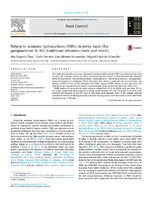| dc.creator | Thea, Ana Eugenia | |
| dc.creator | Ferreyra, Darío Jorge | |
| dc.creator | Brumovsky, Luis Alberto | |
| dc.creator | Schmalko Radichowski, Miguel Eduardo | |
| dc.date.accessioned | 2023-01-26T13:27:06Z | |
| dc.date.available | 2023-01-26T13:27:06Z | |
| dc.date.issued | 2016-02-01 | |
| dc.identifier.citation | Thea, A. E., Ferreira, D. J., Brumovsky, L. A., y Schmalko, M. E. (2016). Polycyclic aromatic hydrocarbons (PAHs) in yerba maté (Ilex paraguariensis St. Hil) traditional infusions (mate and tereré). Food Control. Amsterdam, Países Bajos: Elsevier; 60(1), pp. 215-220. | es_AR |
| dc.identifier.issn | 0956-7135 | |
| dc.identifier.other | CCPI-CNyE-A-029 | |
| dc.identifier.other | 6588 | |
| dc.identifier.uri | https://hdl.handle.net/20.500.12219/4332 | |
| dc.description | Fil: Thea, Ana Eugenia. Universidad Nacional de Misiones. Facultad de Ciencias Exactas, Químicas y Naturales; Argentina. | es_AR |
| dc.description | Fil: Ferreyra, Darío Jorge. Universidad Nacional de Misiones. Facultad de Ciencias Exactas, Químicas y Naturales; Argentina. | es_AR |
| dc.description | Fil: Brumovsky, Luis Alberto. Universidad Nacional de Misiones. Facultad de Ciencias Exactas, Químicas y Naturales; Argentina. | es_AR |
| dc.description | Fil: Schmalko Radichowski, Miguel Eduardo. Universidad Nacional de Misiones. Facultad de Ciencias Exactas, Químicas y Naturales; Argentina. | es_AR |
| dc.description.abstract | This study describes the occurrence of polycyclic aromatic hydrocarbons (PAHs) in traditional yerba maté hot and cold infusions ( mate and tereré), by monitoring the content of benz[a]anthracene, chrysene, benzo[b]fluoranthene, benzo[k]fluoranthene, benzo[a]pyrene, dibenz[ah]anthracene, benzo[ghi]perylene and indeno[1,2,3-cd]pyrene (PAH8), that have been chosen as indicators for the occurrence and toxicity of PAHs in food by the European Food Safety Agency. PAH8 content in mate and tereré was determined by high performance liquid chromatography using fluorescence detection (HPLC-FLD).PAH8 contents in hot and cold maté infusions ranged from 371.2 to 2438.8 ng/L and from 19.2 to 937.3 ng/L, respectively. Benzo[a]pyrene contents varied between 37.0 and 373.9 ng/L in hot yerba maté infusions and between 7.0 and 92.1 ng/L in cold yerba maté infusions. None of the samples analyzed exceeded the World Health Organization criteria for drinking water, since the maximum level allowed for benzo[a]pyrene is 700 ng/L. | en |
| dc.format | application/pdf | |
| dc.format.extent | 437.4 KB | |
| dc.language.iso | eng | en |
| dc.publisher | Elsevier | en |
| dc.relation | info:eu-repo/semantics/altIdentifier/url/https://www.sciencedirect.com/science/article/abs/pii/S0956713515301341 | |
| dc.rights | info:eu-repo/semantics/openAccess | |
| dc.rights.uri | http://creativecommons.org/licenses/by-nc-sa/4.0/ | |
| dc.subject | Polycyclic aromatic hydrocarbons (PAHs) | en |
| dc.subject | Ilex paraguariensis | en |
| dc.subject | Yerba mate | es_AR |
| dc.subject | Infusions | en |
| dc.subject | HPLC-FLD | en |
| dc.title | Polycyclic aromatic hydrocarbons (PAHs) in yerba mate (Ilexparaguariensis St. Hil) traditional infusions (mate and terere) | en |
| dc.type | info:eu-repo/semantics/article | |
| dc.type | info:ar-repo/semantics/artículo | |
| dc.type | info:eu-repo/semantics/publishedVersion | |




